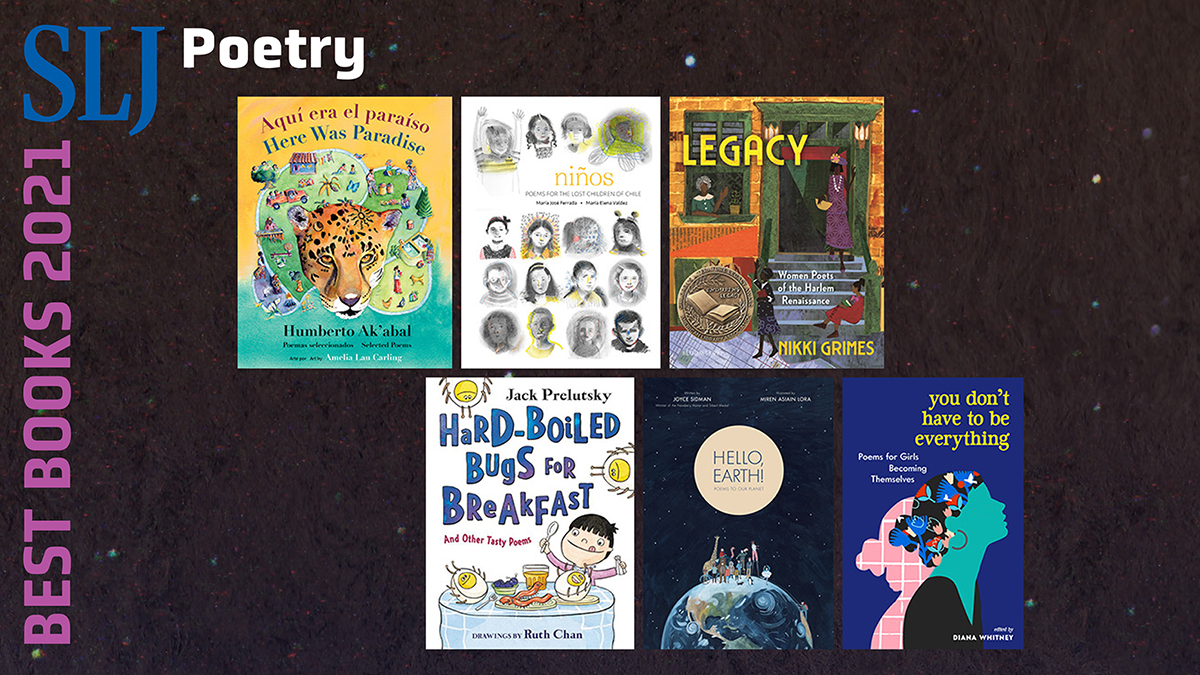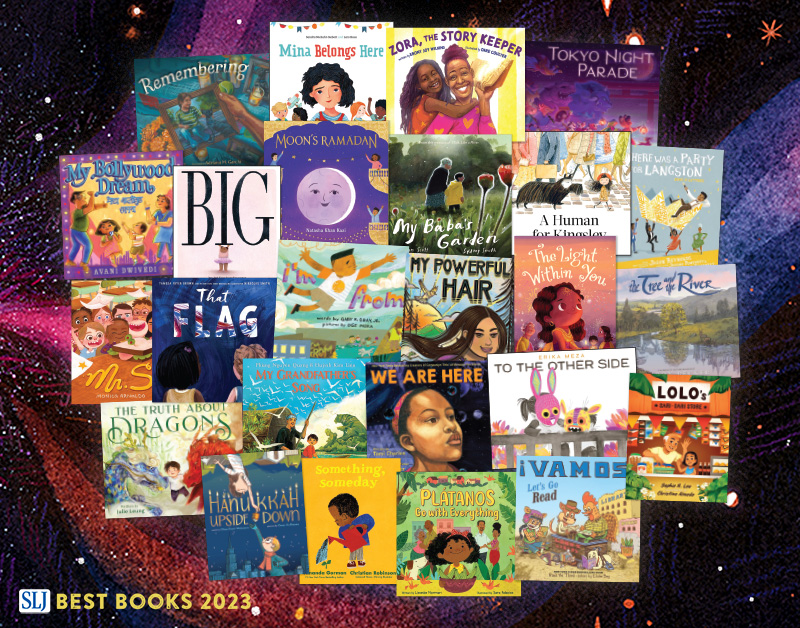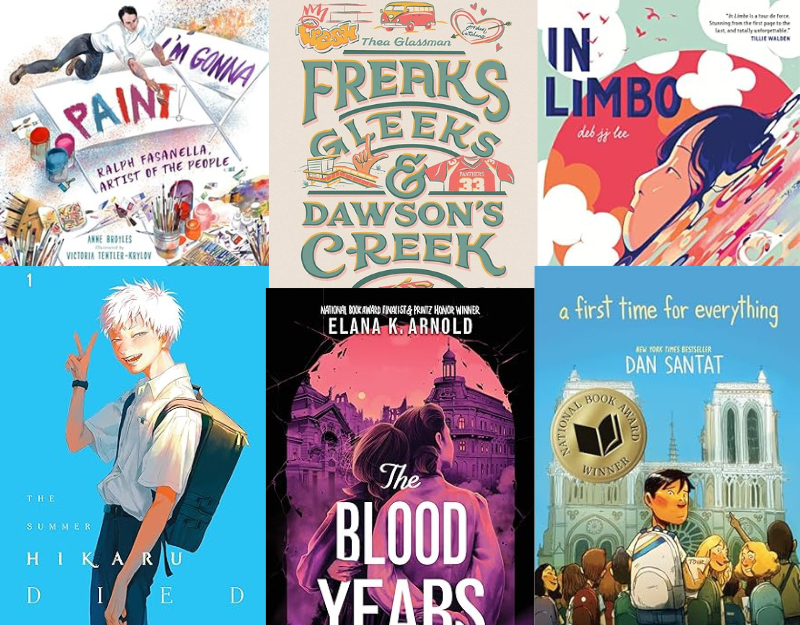Review of the Day: Papá’s Magical Water-Jug Clock by Jesús Trejo, ill. Eliza Kinkz
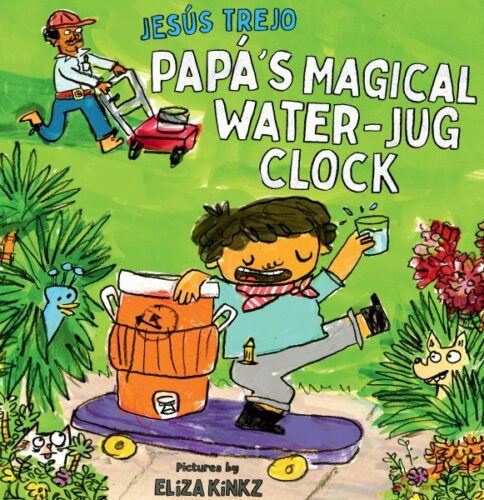
Papá’s Magical Water-jug Clock
By Jesús Trejo
Illustrated by Eliza Kinkz
Minerva (an imprint of Astra Books for Young Readers)
ISBN: 9781662651045
$18.99
Ages 4-7
Rules for Creating Great Picture Books: You don’t need unicorns. Not really. You don’t need magic at all. I mean, if you want to include magic then go for it! It’s all yours! But it’s not an ingredient to storytelling that’s 100% necessary. When I look at some of the great picture books of all time, often the ones starring humans are of a realistic bent. Your Madeline or Alexander and the Terrible, Horrible, No Good, Very Bad Day tales. And certainly, when the right combination of art and text is brought together, almost any plot has the potential for brilliance. Even a story as simple as a kid helping out his dad with his lawncare job can be fun if you know how to spin it. And spinning, apparently, is something Jesús Trejo excels at. An expert combination of kid-logic and hilarious art in the book Papá’s Magical Water-jug Clock takes something as mundane as gardening and turns it into full-on wacky hijinks. Hijinks that trump magic every time.
Woohoo! Jesús is up at the crack of dawn because today’s the day he’s been waiting for. It’s Saturday! The day he gets to help Papá in his work as a gardener! And as he fills the water jug, Papá informs Jesús that that is no ordinary container. Nope! It’s like a magical clock. When the water runs out inside, that’ll mean it’s time to go home. Even better, Jesús is put in charge of the jug. It’s a big responsibility but the kid is up for the challenge. Which is to say, he’s up for speeding that clock up as fast as possible. At the first house he gives drinks to all the elderly kitties. At the second house, water is going to the tiny dog that lives there. At the third house? Note the thirsty peacocks. You can imagine Papá’s surprise to see the water almost completely gone already. Is it time to go home yet? No, but it is time for Jesús to learn a hard lesson about trying to trick time when there are jobs to do.
ADVERTISEMENT
ADVERTISEMENT
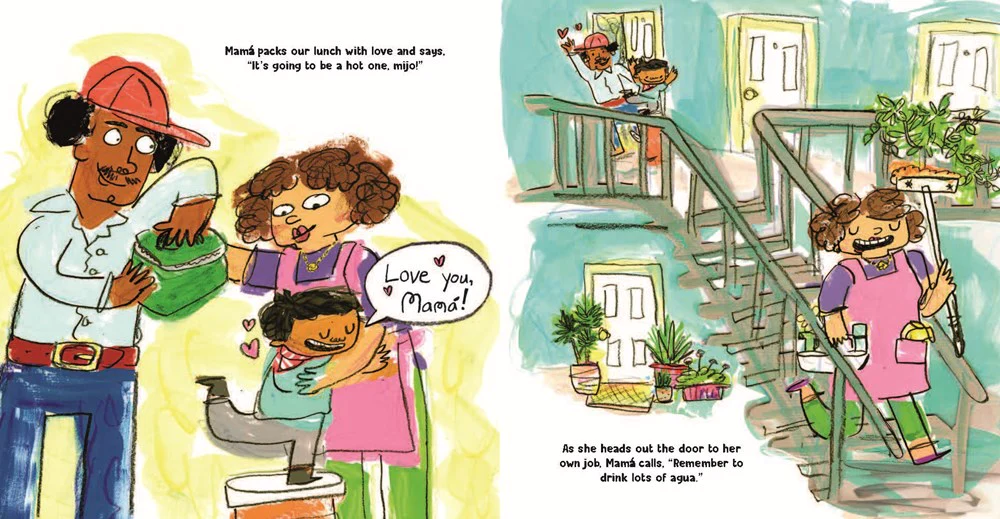
If you look at a lot of Best Children’s Books of the Year lists coming out of library systems like NYPL or CPL, you’ll notice that in recent years they’ve taken a great deal of care to include bilingual and entirely Spanish language children’s book titles. Simultaneously, a fair number of publishers have been careful to create bilingual books in both English and Spanish, or to incorporate Spanish words and phrases into the English text. Of course not every book that uses Spanish words in the story does it well. Sometimes it can feel out-of-place or oddly incorporated. There’s an art to such inclusion and that art is employed perfectly by Jesús Trejo here. Not too long ago every time a picture book would include a Spanish word or phrase it would italicize that word and make a great big deal about it. These days the words are effortlessly included and the end result makes for a smoother read. And I should say that of all the picture books I’ve seen this year, few are quite as smooth as Papá’s Magical Water-jug Clock.
Much of the book’s charm hinges on its application of kid-logic. You know exactly what Papá was thinking when he told Jesús that the water-jug was magic. Jesús is still young enough that hanging out with his dad on his job all day is fun. Giving the kid a little responsibility with something as simultaneously important and unimportant as a water-jug (and extra points if you can make it sound magical) is awesome. But who could blame Jesús for extrapolating a little and taking the magic water-jug idea to its logical conclusion? Work is done when the water-jug is empty? It’s a miracle he doesn’t just tip it all into the gutter somewhere, honestly. The best part of all this is when Papá has to fess up and Jesús has this marvelous moment where the part of all this that makes him the angriest is, “YOU MADE ME THE BOSS OF A REGULAR, NON-MAGICAL, PLAIN OLD WATER JUG?!!!” That’s worth a full-page tantrum right there (though I should note that the boy quickly recants, afraid that he’ll be fired from the family business). What makes this plot work so well is that the tension in the story comes from the common kind of miscommunication that happens every day between parents and their children. They want to keep things interesting for their kids, these parents. They just sometimes forget what literalists little children are.
According to his bio on the bookflap, author Jesús Trejo is a bit of a celebrity with his acting, stand-up, and executive producing. You’d never know it from reading this book, and I mean that in the best possible way. Under normal circumstances a celebrity picture book is a lamentable creation. Well-meaning, placid, and dull. They are inevitably preachy, incalculably boring, and saved only by the brilliance of their underpaid illustrators. This book, in contrast, is peppy, fun, funny, and contains a storyline and tone that I’ve never seen done in a story for kids before. The sole similarity this book has to other celebrity picture books is that it was blessed by the brilliance of a great illustrator. Eliza Kinkz apparently did a book before this called Goldie’s Guide to Grandchilding which I may have to seek out and read on my own. Here she brings her signature whopping big time joy to the page and I am here for it!
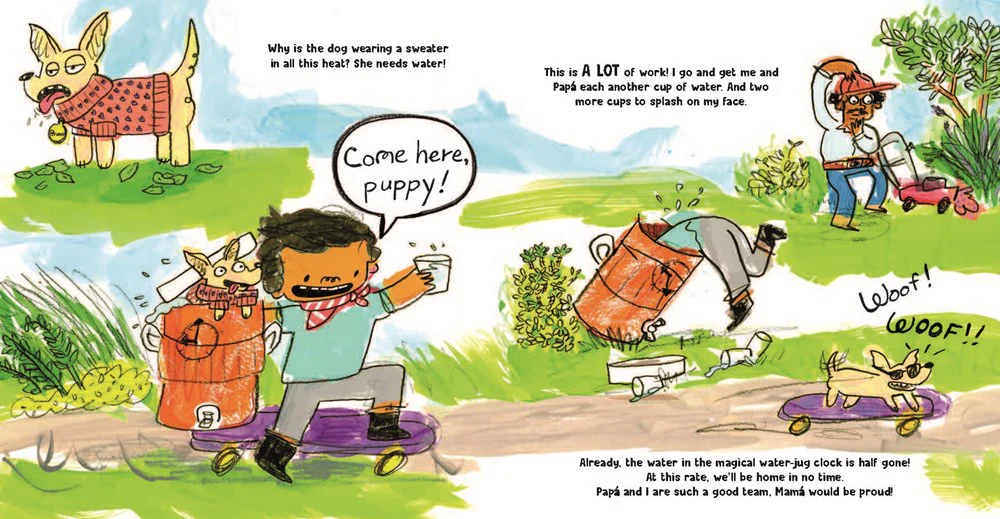
Read the publication page and you’ll see that the art in this book was created with pencil, ink, watercolor, gouache, crayons, “and a few drops of queso.” Nothing wrong with that. The end result, of course, is that you step away from these pages with the understanding that the book is a wild combination of pitch perfect visual gags with flourishes to the art that make it feel like an actual kid had a hand in its creation somewhere along the line. But the true star of the show is clearly Jesús. The energy coming off this kid! He doesn’t run, he springs. Anyone who has ever parented (or babysat) a small child will get where he’s coming from. Add in the fact that Eliza is capable of bringing personality to everything from tall scary trees to elderly cats (perhaps the best old felines I’ve ever seen depicted in a picture book before) and you begin to understand why this book seems to thrum with energy on every page.
ADVERTISEMENT
ADVERTISEMENT
I’d also like to give some credit to how well Eliza creates backgrounds to her scenes. The house? It’s thoroughly lived in, covered in the detritus of having a young kid (toys and action figures and school supplies cast about merrily on the ground). The van? You know this van. This is a working van. And the rope with a written description as “Van Security” reminded me of how ropes are used similarly in this year’s graphic novel Mexikid by Pedro Martín. Ropes in vehicles are having a moment, man. The outdoor settings don’t have the liberty of establishing personality through mess, but Ms. Kinkz does what she can by showing a wide array of different kinds of houses, all in need of gardening work.
I was reading another picture book this year called Yenebi’s Drive to School (by Sendy Santamaria) and in that book the authors had to acknowledge why the child characters in the book were in a car without seatbelts for long periods of time. I suppose they figured it might nip any objections to the book in the bud. Papá’s Magical Water-jug Clock does not suffer this fate (seatbelts are tightly fashioned on everyone) but little Jesús does ride in the front seat in at least one scene. I know some folks might raise an eyebrow at this, but considering the state of the back of the work van, I think it makes a fair amount of sense.
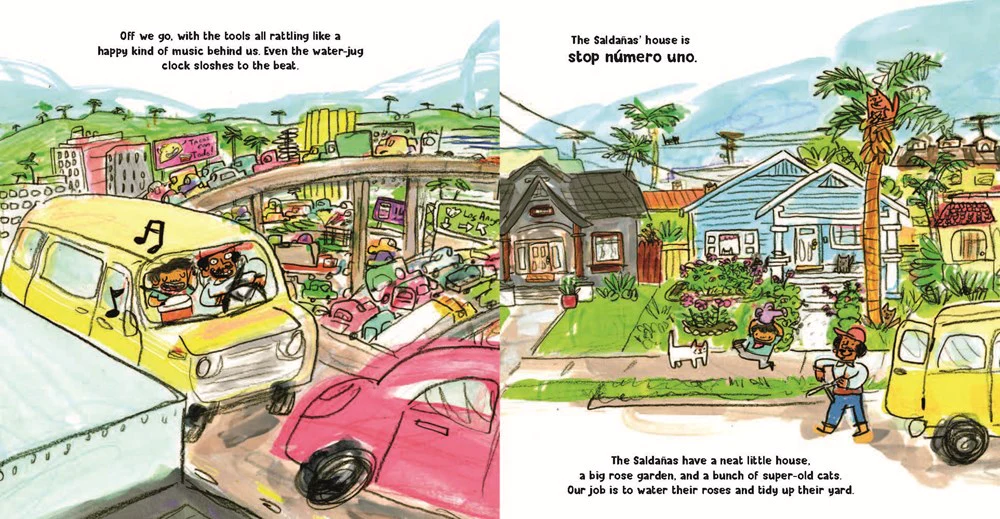
One element I would have loved to have seen in this book would have been an Author’s Note, even a short one. This is a story about a kid named Jesús and the author of the book is named (ready for it?) Jesús. So is this based on a true story? Are there any autobiographical elements to the tale? Not long ago I read a very different helping-my-dad-out-with-yard-work book called Growing an Artist: The Story of a Landscaper and His Son by John Parra. That book was sort of the serious, meaningful version of this one. As such, it would have been cool if this story had included some personal details, even if they were just on the bookflap. Then again, you could still pair Growing an Artist with Papá’s Magical Water-jug Clock if you wanted to. I suspect that if you read both books to kids, you could get a really good discussion going about the similarities and differences between the two.
For a brief, shining moment in a child’s life, they’re thrilled to be helping their parents out with work. Any kind of work, really. It doesn’t last, of course. In a couple years Jesús may be trying to purposefully get himself fired from the family business (and failing). So this is a picture book that has zeroed in on just the right age for just the right readership. The art and writing pair together with absolute perfection, and aside from the odd failure to include any personal information on the part of the author, I’d say it’s just about as perfect a summertime book as you’re likely to find for a while. Clocks and cats, water and magic, and at its heart a father-son storyline. Nab it for your next storytime, whenever you get the chance.
On shelves now.
Source: Final copy sent from publisher for review.
Filed under: Best Books, Best Books of 2023, Reviews, Reviews 2023
About Betsy Bird
Betsy Bird is currently the Collection Development Manager of the Evanston Public Library system and a former Materials Specialist for New York Public Library. She has served on Newbery, written for Horn Book, and has done other lovely little things that she'd love to tell you about but that she's sure you'd find more interesting to hear of in person. Her opinions are her own and do not reflect those of EPL, SLJ, or any of the other acronyms you might be able to name. Follow her on Twitter: @fuseeight.
ADVERTISEMENT
ADVERTISEMENT
SLJ Blog Network
Name That LEGO Book Cover! (#53)
Exclusive: Vol. 2 of The Weirn Books Is Coming in October | News
Fighting Public School Book Bans with the Civil Rights Act
North Texas Teen Book Festival 2024 Recap
ADVERTISEMENT




